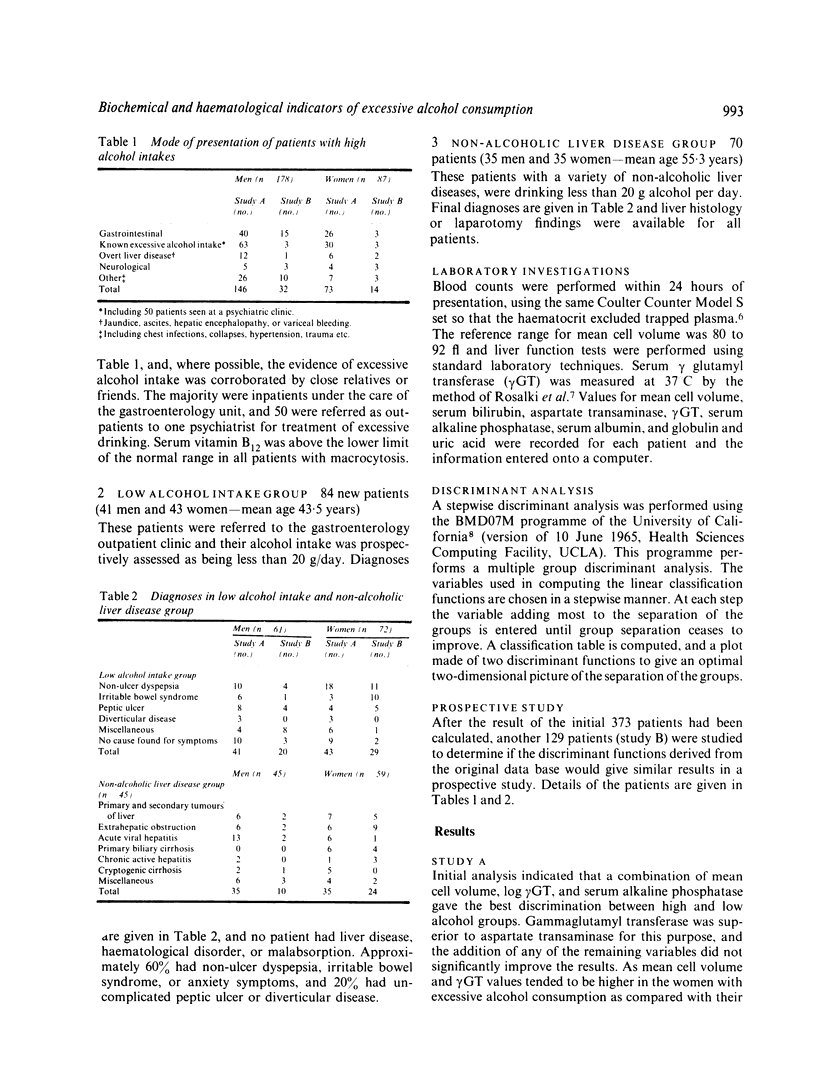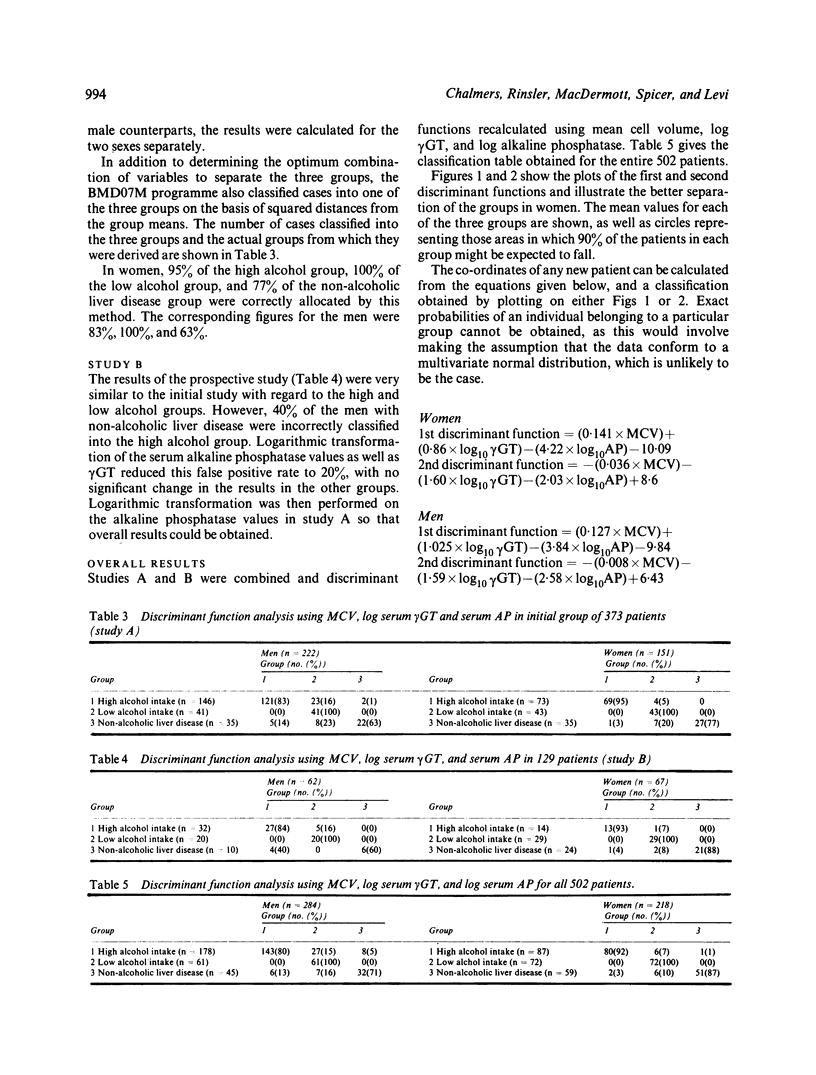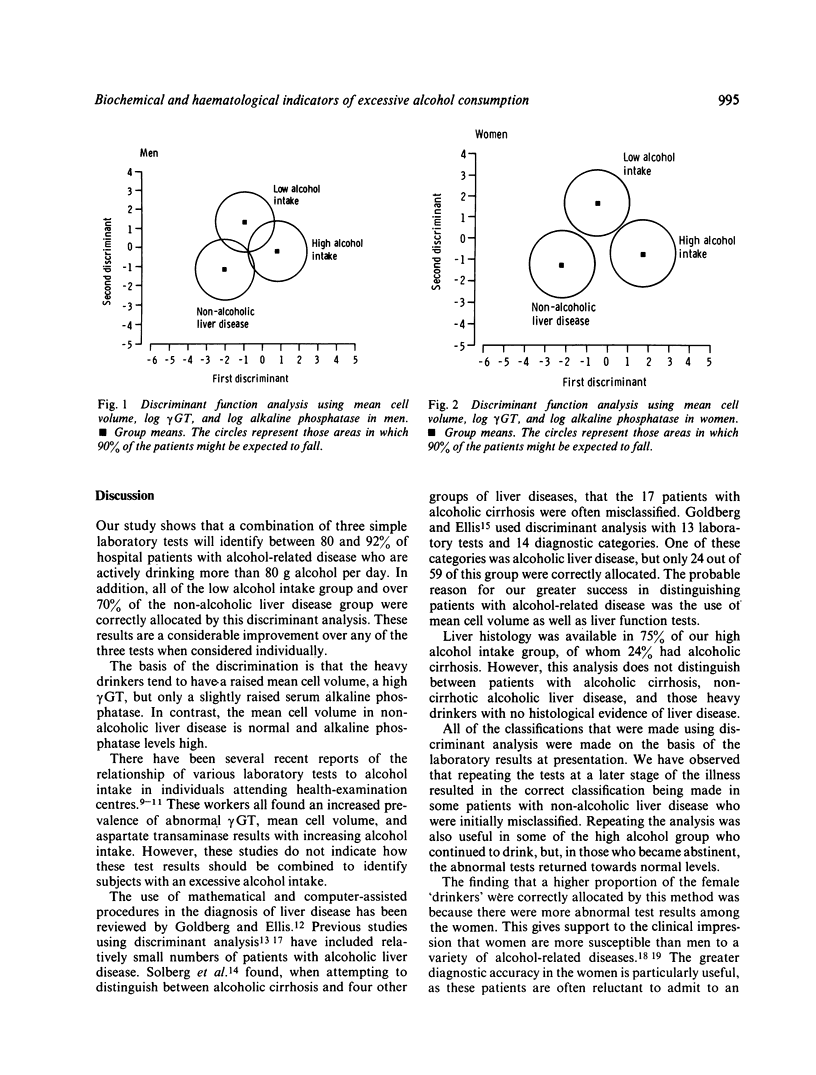Abstract
Discriminant function analysis was used to determine the optimum combination of haematological and biochemical tests which gave the best discrimination between hospital patients with high and low alcohol intakes. We studied 265 patients with alcohol-related disease, 133 gastroenterology outpatients drinking less than 20 g of alcohol per day, and 104 patients with a variety of non-alcoholic liver disease. Values of mean cell volume (MCV), serum bilirubin, aspartate transaminase, serum alkaline phosphatase (AP) and gamma glutamyl transferase (gamma GT), serum albumin, serum globulin, and uric acid were determined in each patient. The best discrimination between the three groups of patients was provided by a combination of mean corpuscular volume, log10 gamma GT, and log10 serum alkaline phosphatase. In women, 92% of the high alcohol group, 100% of the low alcohol group, and 87% of the non-alcoholic liver disease were correctly allocated by the discriminant analysis. The corresponding figures for the men were 80%, 100%, and 71%. Thus, over 80% of patients with excessive alcohol intake were correctly allocated by the use of three simple laboratory tests.
Full text
PDF




Selected References
These references are in PubMed. This may not be the complete list of references from this article.
- Ashley M. J., Olin J. S., le Riche W. H., Kornaczewski A., Schmidt W., Rankin J. G. Morbidity in alcoholics. Evidence for accelerated development of physical disease in women. Arch Intern Med. 1977 Jul;137(7):883–887. doi: 10.1001/archinte.137.7.883. [DOI] [PubMed] [Google Scholar]
- Bagrel A., d'Houtaud A., Gueguen R., Siest G. Relations between reported alcohol consumption and certain biological variables in an "unselected" population. Clin Chem. 1979 Jul;25(7):1242–1246. [PubMed] [Google Scholar]
- Chalmers D. M., Chanarin I., Macdermott S., Levi A. J. Sex-related differences in the haematological effects of excessive alcohol consumption. J Clin Pathol. 1980 Jan;33(1):3–7. doi: 10.1136/jcp.33.1.3. [DOI] [PMC free article] [PubMed] [Google Scholar]
- Ellis G., Goldberg D. M. Discriminant function analysis applied to laboratory tests in patients with hepatobiliary disease. Comput Biomed Res. 1979 Oct;12(5):483–501. doi: 10.1016/0010-4809(79)90034-x. [DOI] [PubMed] [Google Scholar]
- England J. M., Fraser P. M. Differentiation of iron deficiency from thalassaemia trait by routine blood-count. Lancet. 1973 Mar 3;1(7801):449–452. doi: 10.1016/s0140-6736(73)91878-3. [DOI] [PubMed] [Google Scholar]
- England J. M., Walford D. M., Waters D. A. Re-assessment of the reliability of the haematocrit. Br J Haematol. 1972 Aug;23(2):247–256. doi: 10.1111/j.1365-2141.1972.tb03477.x. [DOI] [PubMed] [Google Scholar]
- Fraser P., Healy M., Rose N., Watson L. Discriminant functions in differential diagnosis of hypercalcaemia. Lancet. 1971 Jun 26;1(7713):1314–1319. doi: 10.1016/s0140-6736(71)91885-x. [DOI] [PubMed] [Google Scholar]
- Goldberg D. M., Ellis G. Mathematical and computer-assisted procedures in the diagnosis of liver and biliary tract disorders. Adv Clin Chem. 1978;20:49–128. doi: 10.1016/s0065-2423(08)60020-7. [DOI] [PubMed] [Google Scholar]
- Plomteux G., Toulet J., Albert A., Amrani N. Traitement statistique des données biochimiques par la méthode d'analyse discriminante. Sélection des variables biochimiques discriminantes. Essai de discrimination biochimique de la cholostase intrahéatique de l'obstacle extrahépatique et du cancer du foie. Ann Biol Clin (Paris) 1975;33(6):411–422. [PubMed] [Google Scholar]
- Rosalki S. B. Gamma-glutamyl transpeptidase. Adv Clin Chem. 1975;17:53–107. doi: 10.1016/s0065-2423(08)60248-6. [DOI] [PubMed] [Google Scholar]
- Sher P. P. Diagnostic effectiveness of biochemical liver-function tests, as evaluated by discriminant function analysis. Clin Chem. 1977;23(4):627–630. [PubMed] [Google Scholar]
- Solberg H. E. Editorial: Discriminant analysis in clinical chemistry. Scand J Clin Lab Invest. 1975 Dec;35(8):705–712. doi: 10.3109/00365517509095801. [DOI] [PubMed] [Google Scholar]
- Solberg H. E., Skrede S., Blomhoff J. P. Diagnosis of liver diseases by laboratory results and discriminant analysis. Identification of best combinations of laboratory tests. Scand J Clin Lab Invest. 1975 Dec;35(8):713–721. doi: 10.3109/00365517509095802. [DOI] [PubMed] [Google Scholar]
- Whitehead T. P., Clarke C. A., Whitfield A. G. Biochemical and haematological markers of alcohol intake. Lancet. 1978 May 6;1(8071):978–981. doi: 10.1016/s0140-6736(78)90261-1. [DOI] [PubMed] [Google Scholar]
- Whitfield J. B., Hensley W. J., Bryden D., Gallagher H. Some laboratory correlates of drinking habits. Ann Clin Biochem. 1978 Nov;15(6):297–303. doi: 10.1177/000456327801500171. [DOI] [PubMed] [Google Scholar]


